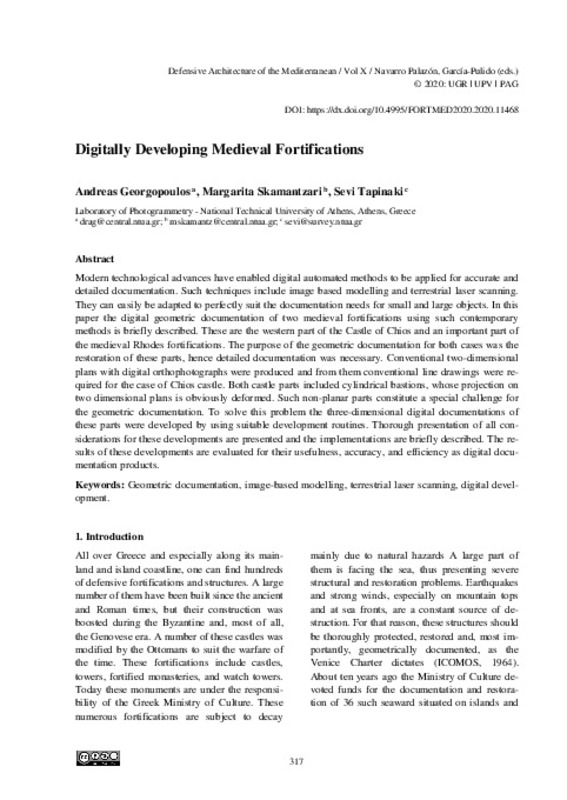JavaScript is disabled for your browser. Some features of this site may not work without it.
Buscar en RiuNet
Listar
Mi cuenta
Estadísticas
Ayuda RiuNet
Admin. UPV
Digitally Developing Medieval Fortifications
Mostrar el registro sencillo del ítem
Ficheros en el ítem
| dc.contributor.author | Georgopoulos, Andreas
|
es_ES |
| dc.contributor.author | Skamantzari, Margarita
|
es_ES |
| dc.contributor.author | Tapinaki, Sevi
|
es_ES |
| dc.coverage.spatial | east=26.136624813079834; north=38.37174162594369; name=Ladis 4, Chios 821 00, Grècia | es_ES |
| dc.coverage.spatial | east=28.224048614501953; north=36.44579688362126; name=Platanakia, Rodos 851 00, Grècia | es_ES |
| dc.date.accessioned | 2020-06-25T10:31:40Z | |
| dc.date.available | 2020-06-25T10:31:40Z | |
| dc.date.issued | 2020-05-15 | |
| dc.identifier.isbn | 9788490488560 | |
| dc.identifier.uri | http://hdl.handle.net/10251/146956 | |
| dc.description.abstract | [EN] Modern technological advances have enabled digital automated methods to be applied for accurate and detailed documentation. Such techniques include image based modelling and terrestrial laser scanning. They can easily be adapted to perfectly suit the documentation needs for small and large objects. In this paper the digital geometric documentation of two medieval fortifications using such contemporary methods is briefly described. These are the western part of the Castle of Chios and an important part of the medieval Rhodes fortifications. The purpose of the geometric documentation for both cases was the restoration of these parts, hence detailed documentation was necessary. Conventional two-dimensional plans with digital orthophotographs were produced and from them conventional line drawings were required for the case of Chios castle. Both castle parts included cylindrical bastions, whose projection on two dimensional plans is obviously deformed. Such non-planar parts constitute a special challenge for the geometric documentation. To solve this problem the three-dimensional digital documentations of these parts were developed by using suitable development routines. Thorough presentation of all considerations for these developments are presented and the implementations are briefly described. The results of these developments are evaluated for their usefulness, accuracy, and efficiency as digital documentation products. | es_ES |
| dc.language | Inglés | es_ES |
| dc.publisher | Editorial Universitat Politècnica de València | es_ES |
| dc.rights | Reconocimiento - No comercial - Sin obra derivada (by-nc-nd) | es_ES |
| dc.subject | Fortifications | es_ES |
| dc.subject | Mediterranean | es_ES |
| dc.subject | Modern age | es_ES |
| dc.subject | Built Heritage | es_ES |
| dc.subject | Geometric documentation | es_ES |
| dc.subject | Image-based modelling | es_ES |
| dc.subject | Terrestrial laser scanning | es_ES |
| dc.subject | Digital development | es_ES |
| dc.title | Digitally Developing Medieval Fortifications | es_ES |
| dc.type | Capítulo de libro | es_ES |
| dc.type | Comunicación en congreso | es_ES |
| dc.identifier.doi | 10.4995/FORTMED2020.2020.11468 | |
| dc.rights.accessRights | Abierto | es_ES |
| dc.description.bibliographicCitation | Georgopoulos, A.; Skamantzari, M.; Tapinaki, S. (2020). Digitally Developing Medieval Fortifications. Editorial Universitat Politècnica de València. 317-324. https://doi.org/10.4995/FORTMED2020.2020.11468 | es_ES |
| dc.description.accrualMethod | OCS | es_ES |
| dc.relation.conferencename | FORTMED2020 - Defensive Architecture of the Mediterranean | es_ES |
| dc.relation.conferencedate | Octubre 01-03,2020 | es_ES |
| dc.relation.conferenceplace | Granada, Spain | es_ES |
| dc.relation.publisherversion | http://ocs.editorial.upv.es/index.php/FORTMED/FORTMED2020/paper/view/11468 | es_ES |
| dc.description.upvformatpinicio | 317 | es_ES |
| dc.description.upvformatpfin | 324 | es_ES |
| dc.type.version | info:eu-repo/semantics/publishedVersion | es_ES |
| dc.relation.pasarela | OCS\11468 | es_ES |








